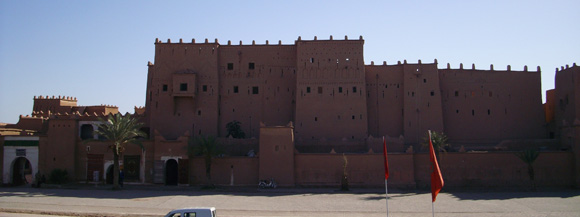 The name Ouarzazate is derived from the combination of the Berber word “ouar” meaning ‘without’ and the Arab-Berber zazate (plural of zaza – ‘noise’). ‘A place without noise ‘ therefore, and a relaxing tranquility is indeed felt in the silence that reigns in this town, a veritable gateway to the immense desert. Here the trans-sahara caravans once passed, linking Marrakesh to Timbuktu. to Mali and to the caravanserai of Sahel. Today Ouarzazate, strategic meeting point of the Dadés, Draa, Sous and Marrakech roads, has become one of the main tourist areas of Morocco, particularly suited to those who seek an experience that is peaceful and as far away as possible from the frenetic modern world.
The name Ouarzazate is derived from the combination of the Berber word “ouar” meaning ‘without’ and the Arab-Berber zazate (plural of zaza – ‘noise’). ‘A place without noise ‘ therefore, and a relaxing tranquility is indeed felt in the silence that reigns in this town, a veritable gateway to the immense desert. Here the trans-sahara caravans once passed, linking Marrakesh to Timbuktu. to Mali and to the caravanserai of Sahel. Today Ouarzazate, strategic meeting point of the Dadés, Draa, Sous and Marrakech roads, has become one of the main tourist areas of Morocco, particularly suited to those who seek an experience that is peaceful and as far away as possible from the frenetic modern world.
Founded in 1928 as a military garrison, the city later became the administrative centre for the Draa region and developed to take on the role as capital of this large and beautiful area with proud historic traditions, situated between the southern slopes of the Grand Atlas and the northern side of the Anti Atlas mountains. The city remained for long on the fringes of mass tourism and although it has recently undergone rapid urban growth it is still famous for Berber ceramics and especially for the carpets of Ouzguita.
THE TAOURIRT CASBAH
Approaching from the Boumalen road for Dadés. near to Ouarzazate is the casbah of Taourirt, a name that combines tha Arab and Berber languages, meaning “hill fortress” – a structure that is of particular interest both for its fine architecture and its perfect integration into the environmental setting. Originally the residence of the pasha of Marrakesh and a symbol of the feudal period of the lords of Atlas, it consists of buildings that had a mainly military function and developed into a fortified city criss-crossed by numerous alleyways. There is a magnificent view from the terrace of the Kasbah, across to the mountains and the lake created by the Mansour ed-Dahbi dam, as far as the oases and enchanting Draa valley.
ATLAS CORPORATION STUDIOS
It is difficult to exaggerate the variety of the Moroccan landscape, the brightness of the light and the magical atmosphere that seems to continually inspire new and original experiences. Thus Morocco has today become one of the favourite film sets of the most famous directors and designers. Scenes from the classic ‘Lawrence of Arabia’ were filmed in the Todghra Gorge, while the Kasbah of AÎT Ben Haddou was the set for ‘Jesus of Nazareth’ and ‘ Tea in the Desert’, and the snowy peaks of the Atlas mountains provided the background for ‘ The Man who would be King ‘. In 1983, in the wake of this new opportunity, a Moroccan businessman already proprietor of the first privately-owned chain of hotels, decided to build Morocco’s first film studios. Located on the edge of Ouarzazate, they extend over 500 hectares, while the buildings alone cover an area of 150 hectares. Equipped with the most modern film-making techniques, the studios have provided the sets for numerous films: ‘ The Jewel of the Nile ‘ (1995 , with Ben Kingsley); ‘Kundun’ (1996, Martin Scorsese); a new edition of ‘Cleopatra’ (1998, with Timothy Dalton); “The Gladiator’ (1998-99, Ridley Scott with Russell Crowe); ‘ Asterix and Cleopatra’ ( 2000, With Gérard Dépardieu).